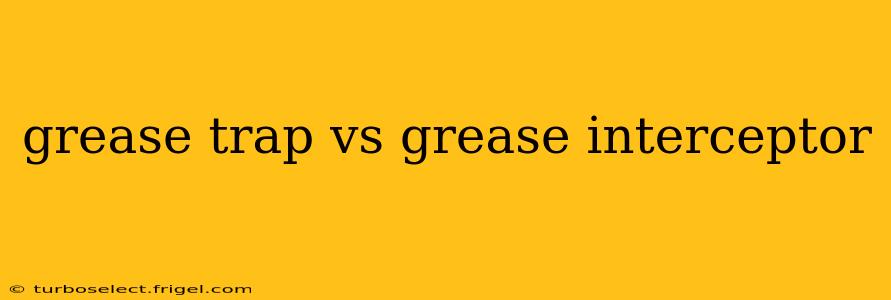Choosing between a grease trap and a grease interceptor can be confusing, especially since the terms are often used interchangeably. While both devices are designed to prevent grease and oil from entering wastewater systems, there are key differences in their design, capacity, and application. Understanding these differences is crucial for ensuring the proper functioning of your plumbing system and complying with local regulations. This comprehensive guide will clarify the distinctions and help you make the right choice for your needs.
What is a Grease Trap?
A grease trap is a relatively simple device typically used in smaller establishments like homes or small restaurants. It's essentially a holding tank where wastewater is slowed down, allowing heavier grease and oil to separate and solidify, floating to the surface or settling at the bottom. The relatively small size and simplicity of grease traps make them a cost-effective solution for managing small amounts of grease. However, this simplicity also means they require more frequent maintenance and cleaning.
How Does a Grease Trap Work?
Wastewater enters the grease trap, its flow slows, and grease and oils separate due to density differences. The separated grease then either floats to the top or settles at the bottom, allowing the cleaner wastewater to flow out. The accumulated grease needs to be regularly pumped out and disposed of properly.
What is a Grease Interceptor?
A grease interceptor, on the other hand, is a more sophisticated and larger system designed for high-volume grease production, typically found in larger commercial kitchens, restaurants, and food processing facilities. They are engineered to handle significantly larger quantities of grease and oil than grease traps, often incorporating more advanced separation methods. Grease interceptors often feature multiple compartments and baffling systems to enhance grease separation efficiency. Their larger capacity reduces the frequency of cleaning and maintenance compared to grease traps.
How Does a Grease Interceptor Work?
Similar to a grease trap, wastewater enters the interceptor. However, the internal design of a grease interceptor uses baffles, chambers, and sometimes even filtration systems to ensure more complete grease removal. The design is optimized to slow the flow of wastewater even further and promote better separation and settling of grease.
Grease Trap vs. Grease Interceptor: Key Differences Summarized
| Feature | Grease Trap | Grease Interceptor |
|---|---|---|
| Size | Smaller, simpler design | Larger, more complex design |
| Capacity | Lower grease handling capacity | Higher grease handling capacity |
| Maintenance | More frequent cleaning required | Less frequent cleaning required |
| Cost | Generally less expensive to install | Generally more expensive to install |
| Applications | Homes, small restaurants, etc. | Larger commercial kitchens, food plants |
| Regulations | May be required by local codes | Often mandated by local codes |
What are the Different Types of Grease Interceptors?
Several types of grease interceptors exist, categorized by their separation mechanism:
- Gravity Interceptors: These rely on gravity to separate grease, employing baffles and chambers to slow wastewater flow.
- Hydrostatic Interceptors: They use the difference in density between water and grease, but often also incorporate more advanced methods of separation.
- Automatic Interceptors: These interceptors feature automatic cleaning mechanisms, reducing manual intervention and maintenance needs.
How Often Should I Clean My Grease Trap or Interceptor?
The cleaning frequency depends on the size of the unit and the volume of grease produced. Grease traps typically need cleaning more frequently – perhaps weekly or bi-weekly for high-volume use – while grease interceptors may only require cleaning every few months or even less frequently for larger models. Always consult local regulations and professional advice for appropriate cleaning schedules. Improper maintenance can lead to serious plumbing issues and environmental concerns.
What Happens If I Don't Maintain My Grease Trap or Interceptor?
Neglecting maintenance can result in:
- Clogged pipes and drains: Accumulated grease can solidify and block pipes.
- Sewage backups: Blockages can cause wastewater to back up into your building.
- Foul odors: Grease build-up leads to unpleasant smells.
- Health code violations: Failure to maintain grease removal systems can lead to fines.
- Environmental damage: Grease discharged into the sewer system can harm aquatic life.
What are the Environmental Concerns?
Discharging grease into the wastewater system has significant environmental consequences. Grease contributes to the formation of fatbergs, massive clumps of solidified grease and other debris that clog sewer lines and damage wastewater infrastructure. Moreover, grease pollutes waterways, harming aquatic life and ecosystems. Proper grease removal is essential for environmental protection.
This detailed comparison should help you understand the key differences between a grease trap and a grease interceptor, enabling you to make an informed decision that meets your specific needs and ensures compliance with environmental regulations. Remember to consult with a plumbing professional for expert advice tailored to your situation.
